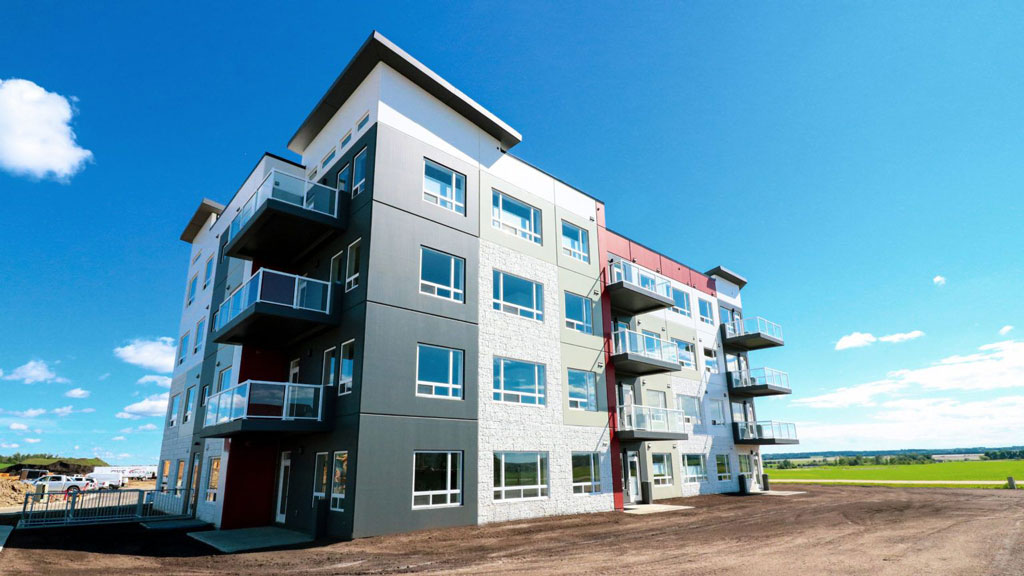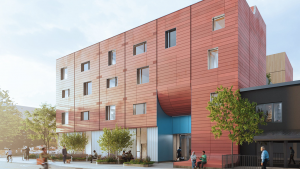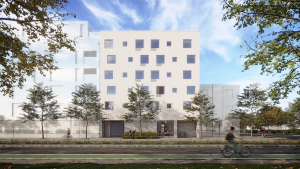Floods, fire, COVID-19 and Canada’s housing shortage have combined to push precast concrete construction deeper into the non-traditional market as a rapid response to growing needs.
While common in the ICI markets, precast is now pushing deeper into the residential sector, paralleling what has been traditional in the European and U.S. markets for the past 30 to 50 years.
In Ontario, the trend to build precast multiple unit residential buildings (MURBs) has “taken off” and has been moving west with Manitoba leading, Alberta and Saskatchewan following and wood-rich B.C. trailing, said managing director Brian Hall of the Canadian Precast/Prestressed Concrete Institute (CPCI). The Institute is the prime source of technical information for precast prestressed concrete in Canada and represents 46 manufacturing members and 57 plants in Canada.
Precast construction brings the attributes of both reduced cost and work efficiencies, said Hall. On larger projects, the ability to work off-site and onsite simultaneously combine to reduce construction schedules by up to a year, he said.
Alberta’s Eagle Builders has been carving out the precast multiple residential unit market for the past 20 years, said Niels Goedhart, Eagle’s sales manager, who calls the company a trailblazer and is now emerging as a leader in field.
Goedhart said the demand is coming from the five-storey-plus market as precast can offer more construction flexibilities than found in traditional concrete construction such as not becoming weather dependent.
The company is currently involved in major residential projects in such urban markets as Kelowna and Edmonton.
Goedhart said his company has also completed a series of precast community living units for seniors in Alberta towns and because of COVID, the precast design allows portions of the building to be isolated in the event of another pandemic.
Cost is driving the market.
“Cash flow,” Goedhart said, echoing Hall.
Using precast in an average mid-rise MURB can reduce the construction time to 15 to 20 days per floor, which can yield as much as a cost-saving of 30 per cent over traditional onsite construction, he estimates.
Banes Lal, marketing manager for Sanderson Concrete, said COVID has spurred precast concrete sales. As more people turned to open spaces to recreate when community centres closed, municipalities looked for rapid solutions to accommodate families in existing parks and precast structures to accommodate others with “pop-up” parks, he said.
Sanderson was able to supply a range of traditional and modern precast picnic tables as well as a line of precast gaming tables such as four-sided checker, foosball and ping-pong tables.
Sanderson also offered a line of precast restroom facilities.
“Everything is done in plant and moved onto site by truck and craned into place,” he said of the washroom facilities. “The final connections are done by the city, but we can install the hardware (sinks, taps, and toilets) here.”
Coquitlam, Surrey and Delta have been early adopters of the precast furnishings and washrooms that are wheelchair accessible.
Lal said the advantages of precast concrete are that it is low maintenance as the concrete components can be coloured and also an anti-graffiti coating can be applied.
Floods and fires have spurred the precast pipe and infrastructure sector.
Jason Omelaniec, technical marketer for the Langley Concrete Group of Companies, which offers precast pipe, said in B.C. the ministry of transportation and highways has started replacing culverts on creeks and rivers to accommodate increased water flows.
“They are always upsizing the dimensions of the culverts and we are seeing some of the older round culverts from the 1970s replaced with precast box culverts,” he said, adding the wider box shape provides a more natural flow for water.
As well, headwall with grills can be positioned to prevent debris clogging.
Omelaniec said there is also a trend to move away from metal culverts, because of the impact of flood waters carrying sand and debris scouring or eroding the metal, especially in older pipe.
“We have heard of one municipality that will no longer allow any metal pipe,” said Omelaniec.
Precast culverts can be manufactured with eight-inch to a foot-thick walls and provide stability over a 100-year life.
Omelaniec said another area of rising concern has been plastic culverts in fire prone areas and in California there have been reports where these failed.
PVC pipe, while it is difficult to ignite, can soften at 200 F and turn viscous at 300 F.
If larger culvert pipes near roadways are compromised by the heat of a forest fire, they may impede the ability of fire suppression crews to access an area and, more importantly, allow individuals to escape.
Production of precast concrete products across Canada is an evolving process.
“With the growing needs and changes in the construction industry, the precast concrete industry is always exploring new, innovative technologies and emerging products to fill those gaps,” said Hall.
The institute has in place a strong educational program to showcase products and how they can be used.
More information is available at the CPCI website, www.cpci.ca.
Precast products found at Canadian manufacturers today include infrastructure pipe and culvert, windows, stairwells, outdoor furnishings, firewalls for buildings, structural and architectural walls, girders, hollocore slabs, elevator shafts and shear walls, right through to companies that can assemble the whole building’s structure.
Alberta Precast Products has become the first precaster in Western Canada to manufacturer a 16-inch hollowcore 65-foot clear span beam, said Arek Martul, general manager.
Goedhart said a better understanding of what is available in precast concrete can better aid architects and engineers before beginning to draw a design.
Often, he said, precast is only considered after the design is drawn and that doesn’t always return the best economic advantages.
But, change is occurring, he said.
His Alberta company is working with educational institutions such as SAIT and NAIT to attune the younger generation to advantages of precast construction.
“They are getting it into their heads early that there is way more flexibility when working with precast,” he said.











Recent Comments
comments for this post are closed